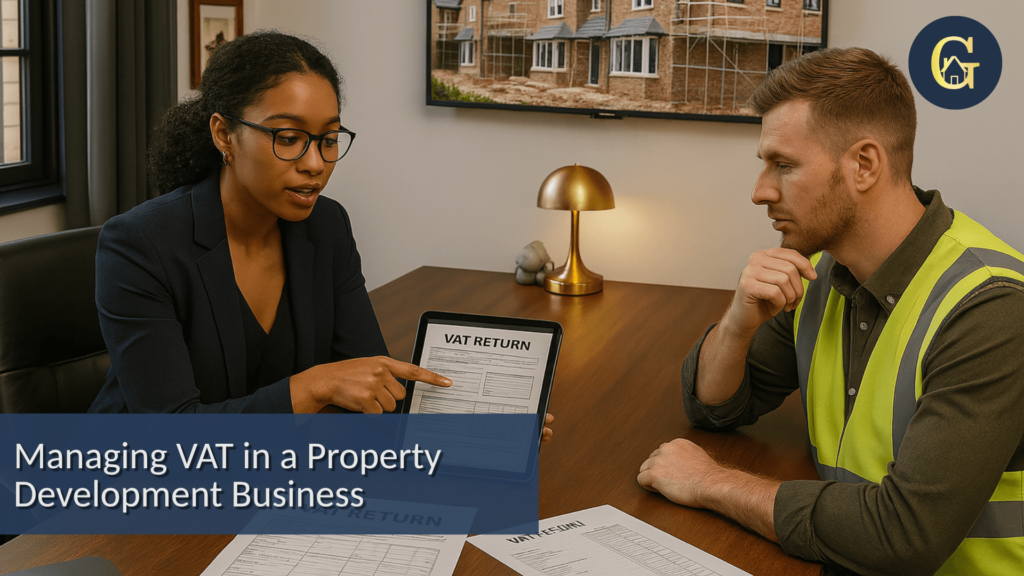VAT can make or break the profit margin in a property development project. Between ever-changing rules, different rates on residential and commercial builds, and complex reclaim processes, it’s no wonder many developers feel overwhelmed.
But when managed correctly, VAT isn’t just a necessary evil, it can be a strategic tool.
Navigating VAT in Construction Projects
Every property deal has a VAT implication and failing to factor it in can lead to major cashflow disruption or missed reclaim opportunities.
VAT isn’t always charged in the same way. Depending on the type of build, conversion, or sale, the VAT rate could be zero, reduced, or standard – or not recoverable at all. The key is understanding what applies before you start.
Whether you’re working on new builds, refurbishments, or commercial conversions, a tailored VAT strategy should be part of your project from day one.
VAT Rates on New Builds, Conversions, and Commercials
Understanding VAT rates is crucial and getting it wrong can be costly. Here’s a simplified breakdown (but always speak to a VAT specialist before you begin):
| Type of Project | Works VAT Rate | Sale VAT Treatment | Can You Reclaim VAT? | Notes |
|---|---|---|---|---|
| New Builds (Residential) | Often zero-rated (0%) or reduced (5%/20%) depending on work type | Usually zero-rated (0%) | Yes – most input VAT on costs can be reclaimed | Must meet HMRC criteria for a qualifying new build. Requires early planning and clear documentation. |
| Conversions (e.g. Commercial to Residential) | Reduced rate (5%) on qualifying works | Usually zero-rated (0%) on first sale | Yes – if criteria are met | Strict rules apply. Not all conversions qualify. Ensure project meets structural change definitions. |
| Residential Refurbishments (Flips) | Standard-rated (20%) unless part of a qualifying conversion | Exempt from VAT | No – VAT on most costs not reclaimable | Exempt sales mean input VAT usually can’t be reclaimed unless part of broader VAT strategy. |
| Commercial New Builds | Standard-rated (20%) | Sale could be 20% or exempt | Yes – but strategy needed | Consider opting to tax to recover VAT. This decision affects future resale and tenants. |
| Commercial Flips (Buy-to-Sell) | Standard-rated (20%) | 20% or exempt depending on whether you’ve opted to tax | Depends – reclaimable if opted to tax | Opting to tax allows VAT recovery but may reduce appeal to certain buyers. |
Remember, in some cases, it’s the works that determine the VAT rate, in others it’s what can be reclaimed – or both. Getting this wrong could mean paying thousands in unrecoverable VAT or triggering HMRC scrutiny.
How to Reclaim VAT and Avoid Penalties
If your project involves reclaimable VAT, you must register for VAT in the correct company (often an SPV) and ensure:
- You reclaim only what’s allowed (some professional fees and white goods are excluded)
- You submit VAT returns on time
- Your invoices are compliant and meet HMRC standards
- You meet all evidence and timing requirements – especially if claiming zero or reduced rate
Improper reclaims can trigger penalties, interest charges, or rejected claims. Worse, you could find yourself paying VAT out of your own profit unnecessarily.
When to Opt to Tax (And When to Avoid It)
Opting to tax a commercial property means electing to charge VAT on rent or sale, allowing you to reclaim input VAT on your build costs.
This can be beneficial if:
- You’re letting to VAT-registered businesses
- Your build involves high VAT input costs
- You plan to sell the property with VAT recovery
However, opting to tax can backfire if:
- Your buyer or tenant isn’t VAT-registered (e.g. charities or individuals)
- You reduce your resale appeal by making the property subject to VAT
- You’ve misunderstood how the election affects mixed-use projects
We help clients assess the short and long-term impact of opting to tax to ensure it supports their investment strategy, not just the immediate project.
Using Reverse Charge Correctly
The VAT domestic reverse charge for construction services means that instead of paying VAT to your subcontractor, you account for it yourself, shifting the VAT liability from supplier to customer.
This rule applies if:
- Both parties are VAT registered
- The services fall under the CIS (Construction Industry Scheme)
- You’re not the end user or intermediary supplier
Getting this wrong is a common mistake, and HMRC penalties can apply. Developers must update contracts, invoice terms, and accounting software to handle reverse charge correctly.
Keeping Clean Records for HMRC and Lenders
Good record keeping isn’t just about compliance, it’s critical for:
- Lender due diligence when refinancing or borrowing
- Speedy VAT reclaims with minimal HMRC pushback
- Clear separation of project costs across SPVs
- Auditable investor reports and performance reviews
We help clients maintain structured project accounts, digital VAT records, and real-time reporting, often integrating these systems with wider cashflow and tax strategy.
Final Thoughts: VAT Doesn’t Have to Be a Headache
Managing VAT in property development doesn’t have to be complicated, but it does have to be strategic.
At GoldHouse, we don’t just help you stay compliant. We help you build VAT into your broader plan: protecting profit, smoothing cashflow, and keeping your projects lender-ready.
From VAT registration and return prep to complex group structures and SSAS pensions, we tailor our advice to your goals, whether you’re building a single site or scaling an international portfolio.
Book a strategy call with GoldHouse today and take VAT off your stress list for good.



